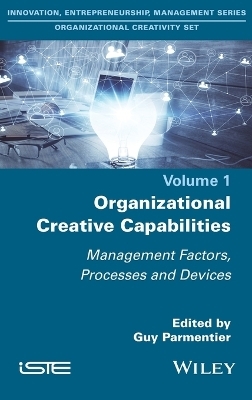
Organizational Creative Capabilities
ISTE Ltd and John Wiley & Sons Inc (Verlag)
9781786308122 (ISBN)
Organizational Creative Capabilities presents a comprehensive approach to creativity, with a view towards building a genuine organizational capability with the potential to deliver strategic advantages. The book provides an understanding of organizational creative capabilities through methods of openness, slack, socialization, agility, equipment and idea management. It provides keys and examples for developing recurrent, value-creating creativity, and also addresses the question of measuring the performance of creative capabilities.
Guy Parmentier is a professor at Université Grenoble Alpes, France. His research and teaching focus on creativity management and business model management in the digital age. He is also head of the ICO research team for Innovation and Organizational Complexity at CERAG, France.
Foreword ix
Patrick COHENDET
Author Biographies xiii
Introduction xvii
Guy PARMENTIER
Chapter 1 The Foundations of Organizational Creative Capabilities 1
Guy PARMENTIER
1.1 Organizational capabilities 1
1.1.1 The different organizational capabilities 3
1.1.2 Approaches for studying organizational capability 6
1.2 Organizational factors of creative capabilities 7
1.2.1 Factors related to the structure of an organization 10
1.2.2 Factors related to an organization's resources 12
1.2.3 Factors related to an organization's vision 13
1.2.4 Factors related to management methods 14
1.3 Organizational routines of creative capabilities 15
1.4 References 22
Chapter 2 Building Openness to Develop Organizational Creative Capability 31
Émilie RUIZ and Guy PARMENTIER
2.1 Open innovation as the beginning of openness 32
2.2 The modalities of openness 34
2.2.1 Boundaries management 34
2.2.2 Managing the governance of openness 38
2.2.3 Knowledge absorption management 39
2.3 The main openness devices that promote creativity 40
2.4 Conclusion 45
2.5 References 47
Chapter 3 Methods, Tools and Spaces for Revealing Employee Creativity 51
Romain RAMPA and Guy PARMENTIER
3.1 Cognitively equipping for creativity: training and methods 52
3.1.1 The C-K theory and the DKCP method 54
3.1.2 Creative problem solving (CPS) 58
3.1.3 Design thinking or empathy at the service of creation 60
3.1.4 Cognitively equipping: issues and limits to be taken into account 62
3.2 Establishing and developing fertile spaces for creativity 64
3.2.1 The advent of virtual spaces? 67
3.3 The role of physical tools and equipment 68
3.4 Discussion and conclusion 69
3.5 References 73
Chapter 4 Creative Slack Enabling Ideas to Emerge, to be Stored and Transform 79
Romain RAMPA and Guy PARMENTIER
4.1 The origins of the slack concept 80
4.2 Creative slack as a pool of ideas 81
4.2.1 The creative slack as a formal idea pool 84
4.2.2 Creative slack as the informal idea pool 86
4.3 Creative slack as room to maneuver 88
4.3.1 The room for time for creativity 89
4.3.2 The room for material and financial resources for creativity 91
4.3.3 The room for interpretation in processes and routines 92
4.4 The different components of creative slack: implications and limitations 94
4.5 References 96
Chapter 5 Agile Methods and Organizational Creativity 101
Florence JEANNOT, Maxime MELLARD and Guy PARMENTIER
5.1 The use of agile methods in the video game industry 104
5.2 The influence of agile methods on the creativity of the video games produced 106
5.3 The central role of organizational creative capability 107
5.3.1 The influence of agile methods on organizational creative capability 108
5.3.2 The influence of organizational creative capability on the creativity of the video games produced 112
5.4 An empirical study 113
5.4.1 Test of the influence of agile methods on the creativity of the video games produced 114
5.4.2 Empirical test of the proposed causal chain 115
5.5 Discussion 117
5.6 References 119
Chapter 6 Idea Management and Idea Socialization in Organizations 127
Guy PARMENTIER, Séverine LE LOARNE-LEMAIRE and Romain RAMPA
6.1 The path of ideas 128
6.1.1 Idea generation 129
6.1.2 Idea development 130
6.1.3 Idea promotion 130
6.1.4 Idea deployment 132
6.2 The challenges of the idea path 134
6.2.1 How can idea generation be intensified? The challenge of idea incubation 134
6.2.2 How can ideas be enriched? The stocking issue 135
6.2.3 How can the idea be enriched? The challenge of its socialization 136
6.2.4 How to select the best idea 137
6.2.5 What impact does the transporter of the idea and the form of the presentation have on selection? 138
6.3 Global idea management 139
6.3.1 Informal idea management 139
6.3.2 Formal idea management 142
6.3.3 Synthesis 146
6.4 Conclusion 147
6.5 References 148
Chapter 7 Measuring Organizational Creative Capabilities 155
Zeinab SHEET, Florence JEANNOT and Guy PARMENTIER
7.1 Theoretical framework 156
7.1.1 Dimensions of OCC 156
7.1.2 The consequence of OCC 158
7.1.3 The control variables 158
7.2 Methodology and procedure for generating items 159
7.2.1 The procedure for generating items 160
7.3 Results and discussion 162
7.3.1 Interview results: qualitative exploration 162
7.3.2 Expert feedback: quantitative exploration 163
7.3.3 Initial scale 163
7.4 Conclusion 165
7.5 Appendix: scale items 166
7.5.1 Socialization of ideas 166
7.5.2 Creating room to maneuver 166
7.5.3 Creative equipment 167
7.5.4 Idea management 167
7.5.5 External openness 168
7.5.6 Organizational agility 169
7.6 References 169
Chapter 8 The Creative Performance of Organizations 175
Bérangère L SZOSTAK
8.1 Proposal of a general framework for creative performance 177
8.1.1 Creative performance: definitions and issues 177
8.1.2 Performance and management of organizational creativity 181
8.2 Measuring performance creativity 184
8.2.1 The creativity ladder 185
8.2.2 Proposal of creative performance indicators: creative KPIs 188
8.3 Conclusion 191
8.4 References 191
Conclusion 195
Florence JEANNOT, Séverinne LE LOARNE-LEMAIRE, Maxime MELLARD, Guy PARMENTIER, Romain RAMPA, Émilie RUIZ, Zeinab SHEET and Bérangère L SZOSTAK
List of Authors 203
Index 205
| Erscheinungsdatum | 10.05.2024 |
|---|---|
| Verlagsort | London |
| Sprache | englisch |
| Gewicht | 680 g |
| Themenwelt | Wirtschaft ► Betriebswirtschaft / Management ► Projektmanagement |
| Wirtschaft ► Betriebswirtschaft / Management ► Unternehmensführung / Management | |
| ISBN-13 | 9781786308122 / 9781786308122 |
| Zustand | Neuware |
| Informationen gemäß Produktsicherheitsverordnung (GPSR) | |
| Haben Sie eine Frage zum Produkt? |
aus dem Bereich


